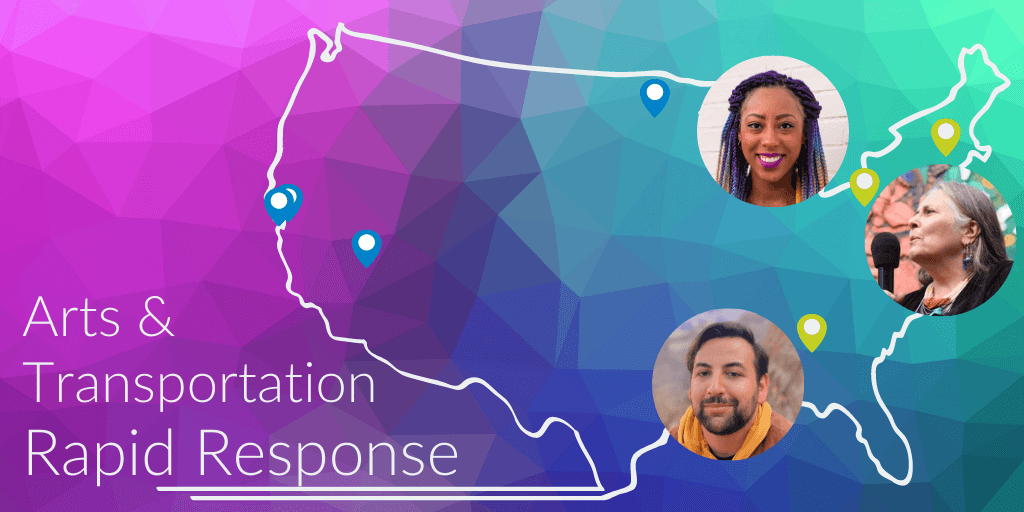
News
By Ebony Venson, September 10, 2021
In partnership with Forecast Public Art, Smart Growth America held a webinar featuring the artists and transportation agencies who worked together as part of the second round of the Arts & Transportation Rapid Response initiative to address COVID-related transportation challenges.
After Ben Stone, director of Arts & Culture at Smart Growth America, and Mark Salinas, Forecast Public Art’s Senior Project Manager, provided an overview of the initiative, we heard a from each of the three stellar projects:
- Atlanta artist Franco Bejarano and Katherine Dirga, Director of Artbound at the Metropolitan Atlanta Rapid Transit Authority (MARTA) shared how they worked together to design a project that thoughtfully addresses MARTA’s unsheltered ridership during the pandemic and provide resources and support to those in need.
- Pittsburg artist Janel Young and Moira Egler, Transit-Oriented Communities Project Manager with the Port Authority of Allegheny County, spoke about their work to develop a bright & innovative mural that encourages riders to “Respect the Space” at local bus stops and on public transit.
- Ware, MA artist Rochelle Shicoff and Jen Healy, Rural Transit Initiative Coordinator with Quaboag Valley Community Development Corporation discussed their work to design a campaign to announce and promote a new fixed-route service that expands equity and access within their community.
Questions
Attendees submitted a number of questions during the Q&A section of the webinar that we weren’t able to answer at the end. We followed up with the presenters to discuss answers to the questions we missed.
Question 1: I see many of these projects are visual, who are blessed with the gifts of seeing and hearing. How are the needs without these gifts portrayed/communicated? Are their representatives being reached?
Moira Egler, Port Authority of Allegheny County: This is the first public art project we have commissioned as an agency in more than a decade, so we are continuing to learn about how to reach those populations through art. The Port Authority does offer tactile and ASL interpreters for all of our public meetings for those who require it, and are committed to serving our riders of all abilities through various resources: https://www.portauthority.org/inside-Port-Authority/rider-info/Accessible-Services-and-Features/
Franco Bejarano, Atlanta, GA artist and social worker: While this project is strictly visual, the homeless outreach team is out every day engaging with individuals, many of whom are seeing or hearing impaired. One could incorporate braille below the posters to address this population.
Question 2: For Janel’s mural, was any special coating applied to protect the ground-based mural, ensure it lasts, and allow for easy cleaning?
Janel Young, Pittsburgh, PA artist: Since this is a temporary installation (less than 2 years), there was no additional coating applied. However, the materials used for this project included traffic paint and outdoor patio enamel paint, both meant for high-traffic tolerance, outdoor use, and longevity.
Question 3: For Shelly, was it different in any way to do public art for a rural area, compared to the work you had done for New York City?
Rochelle Schicoff, Ware, MA artist: The imagery for this rural project emphasized landscape and nature elements such as birds and leaves. I repeated the birds in 2 dimensions on the posters as well as for the cut-out silhouettes on the tops of the 6 installations. They exist in this work as familiar iconography. The leaves on the posters and on the installations (reflective adhesives) were also repeated throughout the project.
Question 4: To the commissioning agencies, do you have any indications at your organizations of sustaining or expanding these types of collaboration with artists? I’m just curious about what lasting impacts these very successful projects might be having as far as how this way of working gets institutionalized
Moira Egler, Port Authority of Allegheny County: We would definitely like to continue working with artists to commission public art for our stations and other property. In April 2021 our board passed a public art policy, which lays out the official process by which we commission public art. This is an exciting step in formalizing a public art program for the agency. While this program is still in its early stages, we hope that integrating public art into our station improvement projects will improve the rider experience and make our spaces more welcoming.
Question 5: How did you get buy-in from the traffic engineers to approve the design for the ground mural. I manage a public art program in our city and they are hesitant to approve asphalt art.
Moira Egler, Port Authority of Allegheny County: This mural was not painted on the asphalt, but on a cement bump-out that extends into the street to increase space at the superstop. It’s also owned by our community partner, Pittsburgh Downtown Partnership, and not the City. This project was framed as a temporary installation piece, which required much less formal design review and approval from the City. The City of Pittsburgh’s Department of Mobility and Infrastructure (DOMI) issued us a temporary permit to install the piece. The City has done its own public art projects on asphalt in the public ROW, which you can learn more about here: https://engage.pittsburghpa.gov/bapr
Question 6: Which sources of funding did these agencies use to pay the artists, and which other types of funds out there would someone suggest?
Ben Stone, Smart Growth America: For these three projects, the artists were each paid by Smart Growth America with funds from the Kresge Foundation. However, transit agencies routinely hire artists and designers to work on similar initiatives without philanthropic support. Many transit agencies have art in transit/public art programs, and many use funds intended for outreach/community engagement to support artists’ work. For additional helpful resources, visit our resources page on the Scenic Route website.
Related News

© 2025 Smart Growth America. All rights reserved
Site By3Lane Marketing










